How to Grow Peaches: Easy Steps for Beginners
- March 4, 2024
- 0 comment
Peaches, with their sweet, juicy flavor and soft texture, are a favorite among fruit enthusiasts. Originating from China, these delightful fruits are not only delicious but also packed with nutrients. Growing your own peach tree can be a rewarding experience, as it allows you to enjoy the freshest peaches right from your backyard. This guide will walk you through the process of growing peaches, from choosing the right variety to harvesting your fruits.
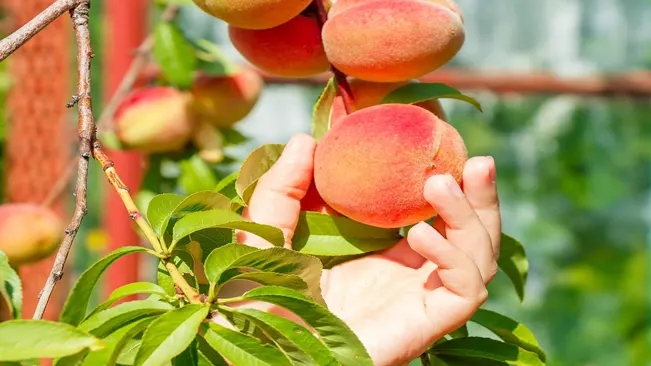
Nutritional Benefits of Peaches
| Benefit | Description |
|---|---|
| Nutritional Value | Peaches are low in calories and contain no saturated fats. They are a good source of vitamins A, C, and E, and include essential minerals like potassium, copper, and manganese. |
| Antioxidant Properties | Rich in antioxidants, peaches help in combating oxidative stress and reducing the risk of chronic diseases. |
| Digestive Health | The dietary fiber in peaches promotes healthy digestion and can help prevent constipation. |
| Skin Health | Vitamins A and C in peaches are beneficial for skin health. They aid in skin regeneration and can help reduce wrinkles and improve overall skin texture. |
| Heart Health | Peaches contain compounds that may help reduce high blood pressure and cholesterol levels, which are beneficial for heart health. |
| Immune System Support | The vitamin C content in peaches helps strengthen the immune system, aiding in the prevention of various infections and illnesses. |
| Eye Health | Beta-carotene, a precursor to vitamin A found in peaches, is essential for eye health and can help prevent vision loss. |
| Anti-Inflammatory Effects | Certain compounds in peaches have anti-inflammatory properties, which can be beneficial in reducing inflammation-related health issues. |
| Weight Management | Low in calories and high in fiber, peaches can be a great addition to a weight management diet. |
| Bone Health | Peaches contain phosphorus and calcium which are vital for healthy bone development and maintenance. |
List on How To Grow Peaches
- Selecting the Right Variety
- Planting Your Peach Tree
- Caring for Your Peach Tree
- Harvesting Your Peaches
Selecting the Right Variety
The first step in growing peaches is to select the right variety for your climate. Peach trees thrive in temperate climates, but some varieties are bred to be more cold-hardy or heat-tolerant. Research the varieties that grow best in your area. Consider factors like the chill hours required, disease resistance, and the size of the mature tree.
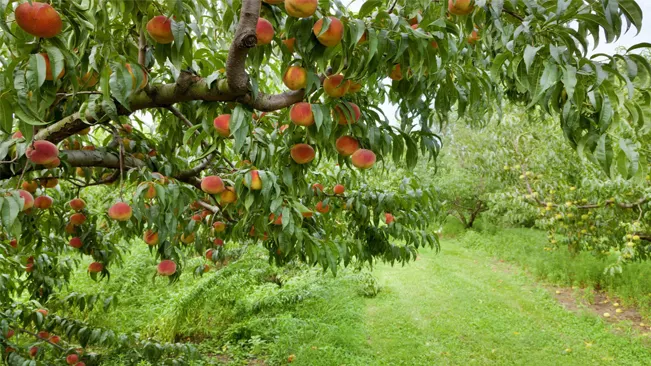
- Climate Adaptability
- Temperate Climates: Most peach trees prefer temperate climates with distinct seasons. If you live in such a region, a wide range of varieties are likely suitable.
- Cold-Hardy Varieties: In areas with harsh winters, look for cold-hardy varieties that can withstand lower temperatures and frost. Examples include the ‘Reliance’ and ‘Contender’ varieties.
- Heat-Tolerant Varieties: In warmer climates, seek varieties that can tolerate heat and have a low chill hour requirement. Varieties like ‘Florida King’ and ‘Desert Gold’ are bred for warmer climates.
- Chill Hours Requirement:
- Peach trees require a certain number of chill hours (hours below 45°F/7°C) during the winter to produce fruit. This requirement varies by variety and ranges from about 200 to over 1000 hours.
- Select a variety that matches your area’s chill hour availability. For example, if your region only gets about 300 chill hours, choose a variety with a low chill hour requirement.
- Disease Resistance:
- Some peach tree varieties are more resistant to common diseases like peach leaf curl, brown rot, and bacterial spot.
- Choosing a disease-resistant variety can save a lot of effort in maintenance and increase the likelihood of a healthy harvest.
- Mature Tree Size:
- Consider the size of the tree at maturity. Standard peach trees can grow quite large, up to 25 feet tall and wide, whereas dwarf varieties grow to about 6-8 feet.
- Dwarf varieties are ideal for smaller spaces and make harvesting easier.
- Fruit Characteristics:
- Different peach varieties offer varying fruit characteristics in terms of flavor, texture, size, and color.
- Some are better for eating fresh (freestone types), while others are preferred for canning or baking (clingstone types).
- Pollination Requirements:
- Most peach trees are self-pollinating, meaning you don’t need multiple trees to produce fruit. However, having more than one tree can increase yield.
- Local Recommendations:
- Consult with local nurseries, agricultural extension services, or experienced gardeners in your area. They can provide valuable insights on the best varieties for local conditions.
Planting Your Peach Tree
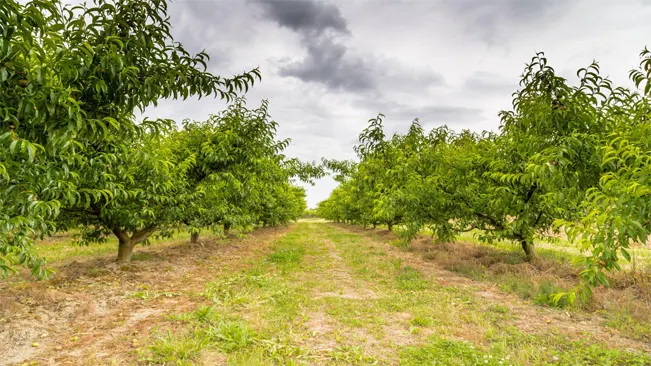
Time to Plant
- Planting during the dormant season is crucial for a few reasons. The cooler temperatures and moist conditions in late winter or early spring help the tree establish its root system more effectively. This preparation allows the tree to focus on top growth when the warmer weather of spring arrives. By establishing roots early, the tree is better equipped to handle heat and drought during its first growing season.
Choosing a Location
- The choice of location is more than just finding a sunny spot. Peach trees need full sunlight to produce the highest quality fruit and achieve optimal growth. The location should also be sheltered from strong winds that can damage the tree and its blossoms. Moreover, consider the air circulation in the chosen location. Good air flow helps in reducing the risks of fungal diseases, which peach trees are prone to.
Soil Preparation
- The health of a peach tree is significantly influenced by the quality of the soil. Well-drained soil is essential to prevent root rot, a common problem in peach trees. If your soil is heavy or clay-like, consider raising the planting bed to improve drainage. Adding organic matter like compost or well-rotted manure not only improves the soil structure but also adds essential nutrients. It’s advisable to test the soil’s pH before planting and adjust it if necessary, as pH can affect nutrient availability to the tree.
Planting Process
- When planting, it’s important to handle the roots gently to avoid damage. If the roots are tightly packed or girdled, gently spread them out in the hole. Ensure that the graft union (a noticeable bump near the base of the trunk where the tree was grafted onto rootstock) is above the soil line. Backfill the hole with the original soil, as this encourages the roots to expand into the native soil. Watering thoroughly after planting helps settle the soil around the roots and eliminates air pockets.
Caring for Your Peach Tree
Watering
Watering is vital for peach trees, particularly during their first growing season when they are establishing their root systems. Here are some key points to consider:
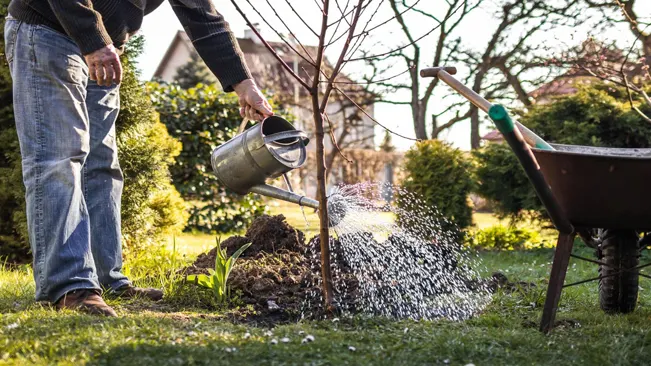
- Frequency and Amount: Water newly planted trees at least once a week, ensuring that the soil is moistened to a depth of about 6 inches. The amount of water needed depends on the soil type and weather conditions. Sandy soils require more frequent watering than clay soils.
- Drip Irrigation: Consider using drip irrigation or a soaker hose to deliver water directly to the roots and minimize evaporation.
- Mulching: Apply a layer of organic mulch around the base of the tree to help retain soil moisture and regulate soil temperature.
- Overwatering Warning: Avoid overwatering as it can lead to root rot. The soil should be moist, not soggy.
Fertilizing
Fertilization is essential for the health and productivity of peach trees:
- Type of Fertilizer: Use a balanced fertilizer, typically one with equal parts nitrogen, phosphorus, and potassium (such as 10-10-10).
- Timing: The first application should be in early spring as the tree breaks dormancy, followed by a second application in early summer. Avoid fertilizing late in the season as it can stimulate new growth that may be damaged by frost.
- Application Method: Apply fertilizer around the drip line of the tree, which is the outermost circumference of the tree’s canopy where it drips onto the ground.
- Young Trees Caution: Be cautious with young trees, as over-fertilizing can damage their roots. Use a lighter application for the first couple of years.
Pruning
Pruning is crucial for maintaining the health and productivity of peach trees:
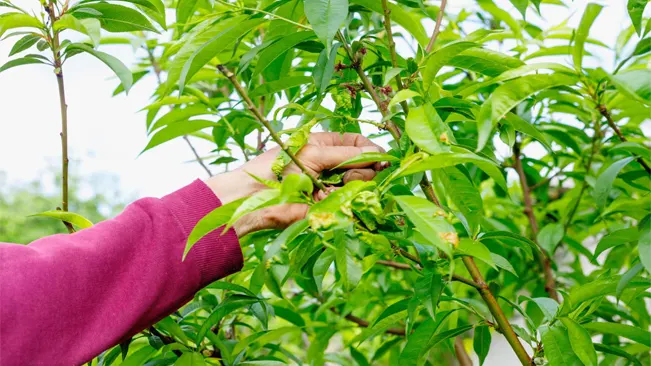
- Best Time to Prune: Late winter or early spring, before the tree breaks dormancy.
- Goal of Pruning: Remove any dead or diseased wood, thin out crowded branches to improve air circulation and sunlight penetration, and maintain an open-center shape.
- Technique: Make clean cuts close to the trunk or main branch to avoid leaving stubs. Thin the canopy to ensure that sunlight reaches the interior of the tree.
- Regular Maintenance: Regular pruning helps to manage the size of the tree and stimulates the growth of new fruiting wood.
Pest and Disease Management
Keeping an eye out for pests and diseases is critical for the health of peach trees:
- Common Pests: Aphids, peach tree borers, and spider mites are common pests. They can be controlled with horticultural oils or insecticides.
- Diseases: Peach leaf curl and brown rot are common diseases. Preventative fungicide treatments in early spring can help.
- Integrated Pest Management (IPM): Use IPM strategies, such as introducing beneficial insects for natural pest control and practicing good sanitation by removing fallen leaves and fruit.
- Regular Monitoring: Regularly inspect your trees for signs of pests or disease and treat promptly to prevent spread.
Harvesting Your Peaches
Peaches typically ripen in mid to late summer, depending on the variety. The fruit is ready to harvest when it is fully colored and slightly soft to the touch. Gently twist the fruit to pick it.
Timing of Harvest
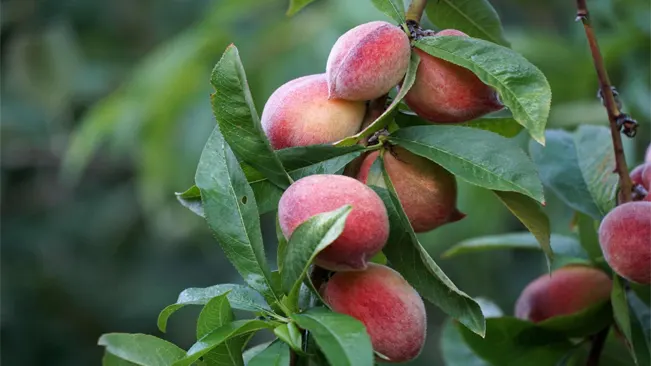
- Variety Dependent: The exact timing for peach harvest varies depending on the variety of peach tree. Some varieties mature earlier in the summer, while others may not be ready until late summer or early fall.
- Climate Impact: Your local climate can also influence when peaches ripen. Warmer regions may see earlier ripening.
Signs of Ripeness
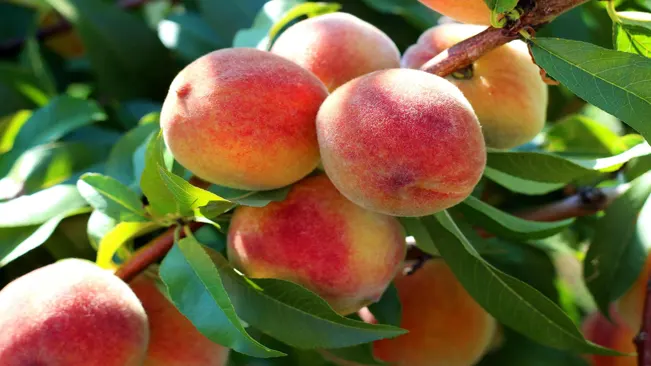
- Color: Look for a full, rich color. The amount of red blush on peaches can vary by variety, but generally, a deeper color indicates ripeness.
- Softness: Ripe peaches will yield slightly to gentle pressure, particularly around the stem area. They should feel soft but not mushy.
- Aroma: A ripe peach will have a sweet and fragrant aroma. If you can smell the sweetness, it’s a good sign that the peach is ready.
- Detachment Ease: When a peach is ripe, it should come off the branch with a slight twist easily. If you have to pull hard, it’s probably not ripe.
Harvesting Method
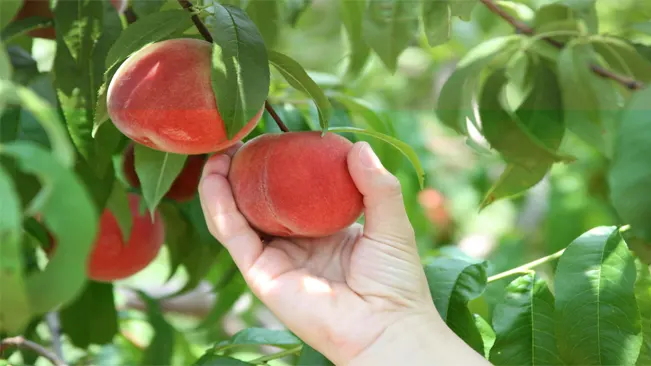
- Gentle Handling: Peaches bruise easily, so handle them with care. Use your hand to support the fruit and twist gently.
- Immediate Use: Peaches picked at their peak are perfect for immediate consumption.
- Storing: If you’re not going to eat the peaches right away, pick them when they are firm but close to ripeness. They will continue to ripen off the tree.
Post-Harvest Care
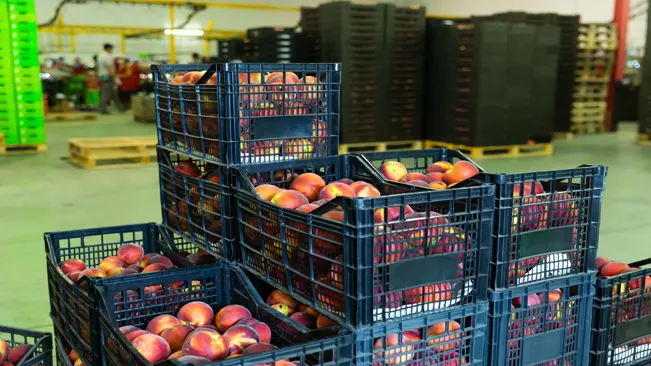
- Ripening Off the Tree: If peaches are slightly underripe when picked, you can let them ripen at room temperature. Avoid direct sunlight.
- Storage: Once fully ripe, peaches can be stored in the refrigerator to slow down further ripening. They usually keep well for about a week.
- Preservation: For long-term storage, peaches can be canned, frozen, or dried. This is an excellent way to enjoy your peach harvest throughout the year.
Conclusion
Growing peaches can be a gratifying experience. With the right care, your peach tree will provide delicious fruits for years to come. Remember, patience and attention to detail are key. Enjoy the process and the sweet rewards of your labor!
FAQs (Frequently Asked Questions)
- What is the best time of year to plant peach trees?
- Plant peach trees during the dormant season, typically late winter or early spring, to give them time to establish roots before the growing season begins.
- Plant peach trees during the dormant season, typically late winter or early spring, to give them time to establish roots before the growing season begins.
- How much sun do peach trees need?
- Peach trees require full sun, at least 6-8 hours of direct sunlight per day, for healthy growth and fruit production.
- Peach trees require full sun, at least 6-8 hours of direct sunlight per day, for healthy growth and fruit production.
- What type of soil is best for peach trees?
- Well-draining soil with a slightly acidic to neutral pH (6.0 to 7.0) is ideal for peach trees. Soil can be amended with compost to improve fertility and drainage.
- Well-draining soil with a slightly acidic to neutral pH (6.0 to 7.0) is ideal for peach trees. Soil can be amended with compost to improve fertility and drainage.
- How often should I water my peach tree?
- Regular watering is crucial, especially during the first year. Keep the soil consistently moist but not waterlogged. Watering needs may vary based on weather and soil type.
- Regular watering is crucial, especially during the first year. Keep the soil consistently moist but not waterlogged. Watering needs may vary based on weather and soil type.
- Do peach trees need a lot of space to grow?
- Peach trees need space for their roots and canopy to spread. Plant them about 15-20 feet apart from other trees or structures.
- Peach trees need space for their roots and canopy to spread. Plant them about 15-20 feet apart from other trees or structures.
- When and how should I prune my peach tree?
- Prune peach trees annually during the dormant season. Remove dead or diseased wood, thin out crowded branches, and maintain an open-center shape to allow sunlight and air circulation.
- Prune peach trees annually during the dormant season. Remove dead or diseased wood, thin out crowded branches, and maintain an open-center shape to allow sunlight and air circulation.
- How long does it take for a peach tree to bear fruit?
- Peach trees typically begin to bear fruit in their third or fourth year after planting.
- Peach trees typically begin to bear fruit in their third or fourth year after planting.
- How do I protect my peach trees from pests and diseases?
- Regularly inspect for signs of pests and diseases. Use appropriate organic or chemical treatments as necessary. Practices like proper pruning, adequate spacing, and maintaining tree health can prevent many issues.
- Regularly inspect for signs of pests and diseases. Use appropriate organic or chemical treatments as necessary. Practices like proper pruning, adequate spacing, and maintaining tree health can prevent many issues.
- Can I grow a peach tree from a peach pit?
- Yes, but it’s a long process and the resulting tree may not produce fruit identical to the parent peach. It’s often better to purchase a grafted tree from a nursery.
- Yes, but it’s a long process and the resulting tree may not produce fruit identical to the parent peach. It’s often better to purchase a grafted tree from a nursery.
- When is the best time to harvest peaches?
- Peaches are usually ready to harvest in mid to late summer when they are fully colored and slightly soft to the touch. Gently twist the fruit to pick it.

Kristine Moore
Forestry AuthorI'm Kristine Moore, a seasoned garden landscaping professional with over 30 years of experience. My extensive career has been dedicated to transforming outdoor spaces into stunning, sustainable landscapes. With a deep understanding of horticulture, design principles, and environmental stewardship, I have become a respected figure in the field, known for creating harmonious, visually appealing, and eco-friendly gardens. My commitment to excellence and continuous learning in landscaping trends and techniques has solidified my reputation as an expert in garden design and implementation.





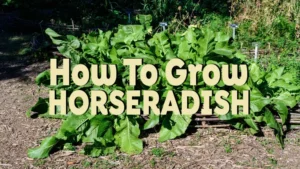

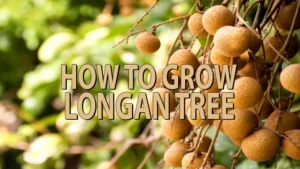


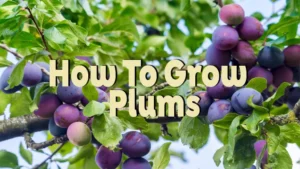


Leave your comment